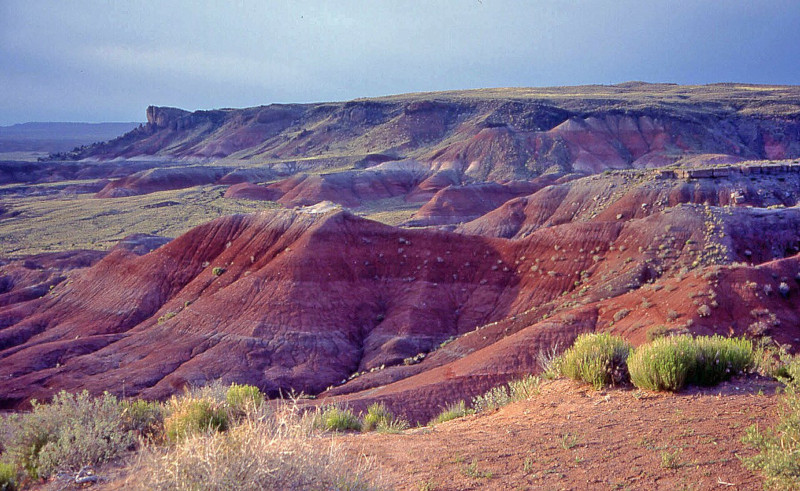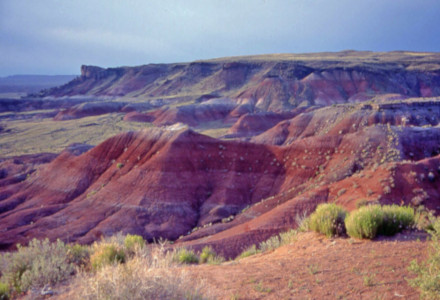
Painted Desert Facts
- Perhaps most notably, the term Painted Desert applies to a geological formation unlike anything else in its portion of the globe. That’s instantly obvious to those who see it. Without doubt, this magnificent work of Nature certainly does live up to its name.
- This incredible landscape just seems to perfectly display Nature’s brushstrokes for us to behold and appreciate their majesty. This astonishing geological formation also formed in a region of the world already well known for its many natural wonders.
- In point of fact, the breathtaking site formed in a beautiful but rugged region. This comprises an area that stretches across portions of what now represents both the Petrified Forest National Park and the Grand Canyon National Park.
- One factor of its formation now serves to provide it with a certain measure of protection. The majority of the rugged terrain of the site lies within land belonging to the Navajo Nation. Large portions of the area can only be accessed by foot or dirt roads.
- The truly gorgeous landscape of the aptly named Painted Desert further has a potential dark side to it. Its beauty does come with a bit of a potential price for the unwary. That’s because, while beautiful, the area also remains quite dangerous.
- As a result of this natural characteristic, very specific precautions now exist for the safety of the intrepid and determined visitors. Travelling the rugged dirt roads of the arduous region now requires the acquisition of a very special permit.
Related Articles
Painted Desert Geology
The local Native American tribes take strict, but laudable precautions. These include carefully restricting access to the stunning Painted Desert. This the local population does to protect both its natural beauty, as well as the safety of the tourists themselves.
Thankfully, the traditions of these Indigenous Peoples have always respected the many wonders of Nature. Not surprisingly, this marvelous work of Nature formed from a highly unique combination of extremely slow, but nonetheless inexorable, factors.
That holds true due to the very distinct and complicated nature of the formation itself. This occurs due to the presence of a special combination of stratified layers of mudstone, shale, and sandstone. Millions of years of erosion subsequently exposed those layers.
The layers displayed in the Painted Desert also have different compositions. Each contains large quantities of both manganese and iron. As a result of the presence of these, the different concentrations of the minerals form the source of varying colors and shades.
Painted Desert Location and Climate Base
The wonder of the painted Desert formed in a section of the world already well known for its natural wonders. That’s because it formed in a rugged and remote portion of what’s now known as North America. Even there, though, its great beauty stands out.
More precisely, this wondrous example of the work of powerful geological processes forms part of the area presently known to many as the Badlands. That fascinating region, itself a natural work of art, sits in the remarkable Four Corners portion of the United States.
In addition to the deposits of minerals and subsequent erosion, other factors played a role in the creation of this masterpiece. Layers of ash from ancient volcanic activity contributed their own colors to the beauty of the area. The combination created a vivid effect.
This location deserves notice for yet another reason. That’s due to its sheer size, in total area, as well as its great visual beauty. In fact, the total area of the region equals roughly 93,500 acres (42,500 hectares). However, its size also leads to certain environmental factors.
That holds true since the region also has a unique climate. This occurs due to the rain shadow of the nearby formation known as the Mongolian Rim. As a result, the local summers become hot and dry. Winters in the Painted Desert become quite cold, though.
Features Sharing Its Region
Havasu Falls Coyote Gulch Antelope canyon
Check out our other articles on 5 Rare Mind-Blowing Cloud Types, Crowned Eagle, Mou Waho Island, Monkey Puzzle Tree, Tree Kangaroo, Picasso Bug, Eastern Diamondback Rattlesnake

